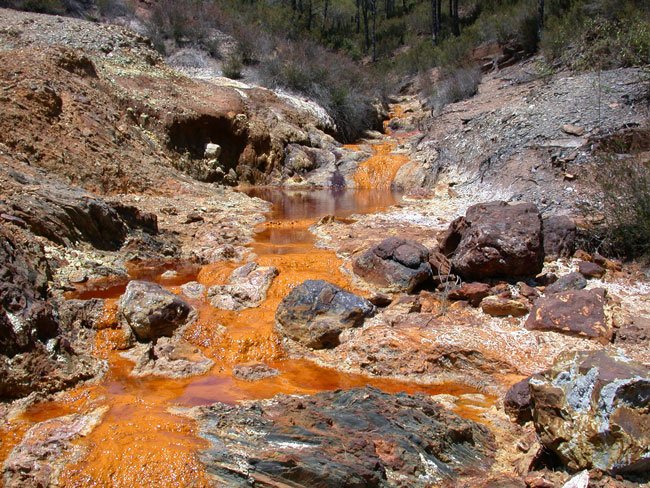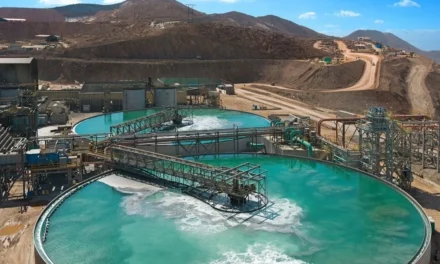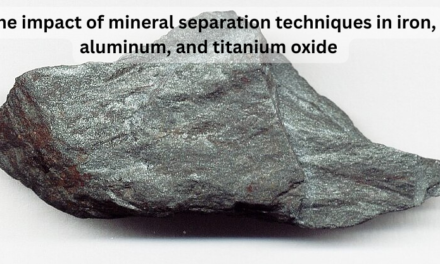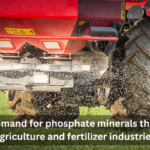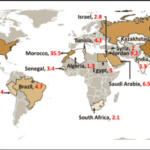Mining sulfate minerals, such as gypsum, barite, and anhydrite, has important industrial benefits but also brings significant environmental concerns. These concerns mainly stem from water contamination, soil degradation, air pollution, and energy consumption. However, many of these issues can be mitigated with careful planning, advanced technologies, and sustainable mining practices.
1. Acid Mine Drainage (AMD)
Concern:
Acid mine drainage (AMD) is one of the most significant environmental problems associated with sulfate mineral mining, especially for sulfide-bearing ores like pyrite (FeS₂). When exposed to air and water, sulfides in the ore oxidize and form sulfuric acid (H₂SO₄). This acid can leach toxic metals from surrounding rocks, contaminating nearby water sources and harming aquatic life.
- Sulfate minerals such as pyrite and gypsum contribute to AMD, as the oxidation of pyrite produces acidic waters and leads to the formation of sulfate ions (SO₄²⁻), which increase the acidicity of surrounding waters.
Mitigation Strategies:
- Water treatment: One of the most effective methods to treat acid mine drainage is through the use of neutralizing agents such as lime (CaO) or alkaline materials like sodium hydroxide (NaOH) to increase pH and neutralize the sulfuric acid. This process helps prevent the release of harmful metals into water sources.
- Wetland treatment systems: Constructed wetlands can be used to neutralize acidified water and remove dissolved metals. The plants and microbes in these systems can naturally treat contaminated water before it reaches nearby water sources.
- Sulfur trapping: In some cases, sulfur can be captured as elemental sulfur or converted into gypsum (CaSO₄) to avoid its release into the environment.
- Sealing waste rock: To reduce oxygen and water exposure to sulfide-bearing minerals, waste rock piles can be sealed or covered with impermeable materials to prevent oxidation and subsequent acid generation.
2. Soil and Water Contamination
Concern:
Mining processes, such as crushing, grinding, and washing, often generate fine particles of sulfate minerals and associated heavy metals that can contaminate soil and water. Gypsum, for example, is often used in agriculture but if mined improperly, can result in over-saturation of calcium and sulfates in the soil, leading to salinity issues that affect soil fertility.
Mitigation Strategies:
- Proper waste disposal: Establishing tailings ponds or settling basins to contain mining waste can prevent the spread of contaminants into nearby water sources. These systems must be designed to prevent leaching of harmful substances.
- Efficient water management: Using closed-loop water systems in mining operations ensures that water is recycled and reused, reducing the risk of contamination.
- Controlled gypsum application: In agriculture, gypsum must be used in controlled quantities to prevent soil salinization. When used in mining operations, gypsum should be properly tested before being distributed for agricultural or construction purposes.
3. Air Pollution and Dust Emissions
Concern:
Mining and processing sulfate minerals often generate large amounts of dust, which can contain particles of the minerals themselves, along with harmful metals and toxins. This dust can be harmful to the health of miners and nearby communities. Additionally, the sulfur dioxide (SO₂) released during the oxidation of sulfide minerals can contribute to acid rain, which has detrimental effects on ecosystems.
Mitigation Strategies:
- Dust suppression techniques: Using water sprays or dust suppressants such as foam, polymer-based agents, or dust collection systems can help minimize airborne particles from mining operations.
- Sulfur dioxide capture: In cases where sulfuric acid is produced during mining, sulfur dioxide can be captured and converted into useful byproducts such as elemental sulfur or gypsum (for use in construction or agriculture). The Flue Gas Desulfurization (FGD) process is commonly used for this purpose in mining facilities.
- Dust-free hauling and transport: Infrastructures such as conveyor belts, covered trucks, and dust extraction units can help prevent the spread of dust during the transportation of mined materials.
4. Habitat Destruction and Loss of Biodiversity
Concern:
Mining activities can lead to deforestation and habitat destruction as large areas of land are cleared to access sulfate mineral deposits. This can affect local wildlife populations and disrupt natural ecosystems. Additionally, the construction of infrastructure, such as roads and processing plants, may further fragment habitats.
Mitigation Strategies:
- Environmental impact assessments (EIAs): Conducting thorough EIAs before starting any mining project can identify the most sensitive environmental areas, allowing for proper planning and mitigation.
- Rehabilitation and reclamation: Mining companies should implement rehabilitation programs to restore ecosystems post-mining. This may include replanting vegetation, soil restoration, and wildlife corridors to reconnect fragmented habitats.
- Minimizing land disturbance: Mining operations should aim to minimize land disturbance by using underground mining methods where possible, or by optimizing open-pit mining techniques to reduce the affected area.
5. Energy Consumption and Carbon Footprint
Concern:
Sulfate mineral mining and processing often require large amounts of energy for excavation, crushing, grinding, and chemical treatments. This energy consumption contributes to the carbon footprint of mining operations and contributes to global warming.
Mitigation Strategies:
- Energy-efficient technologies: Implementing energy-efficient mining equipment and optimizing mining processes can reduce overall energy consumption. This includes automating operations and using renewable energy sources like solar or wind power to power mining operations.
- Waste heat recovery: Some mining operations capture and reuse waste heat from processing plants to reduce their energy consumption.
- Carbon offset programs: Mining companies can participate in carbon offset programs, such as planting trees or investing in renewable energy projects, to neutralize the environmental impact of their operations.
6. Noise Pollution
Concern:
Mining activities, including drilling, blasting, and the operation of large machinery, produce significant noise pollution, which can disturb local communities and wildlife, particularly in more remote areas.
Mitigation Strategies:
- Noise barriers: Constructing barriers or enclosures around noisy equipment can help reduce the transmission of sound.
- Scheduling operations: Limiting noisy activities to daytime hours or specific times when they will have the least impact on local communities and wildlife.
- Use of quieter machinery: Investing in low-noise machinery or using electric-powered equipment can help reduce noise pollution at mining sites.
Conclusion
While sulfate mineral mining brings industrial benefits, including supplying critical materials like gypsum, barite, and anhydrite, it also raises significant environmental concerns. Issues such as acid mine drainage, soil contamination, air pollution, and biodiversity loss can be mitigated through responsible mining practices, including the use of neutralizing agents, water recycling, dust control technologies, and reclamation efforts. By adopting sustainable mining practices, mining companies can reduce their environmental impact, improve their operational efficiency, and contribute to environmental protection for future generations.
Hashtags
#SulfateMining #EnvironmentalImpact #MiningPollution #SulfateOreExtraction #MiningSustainability #WaterPollution #AcidMineDrainage #EcoMining #SustainableMining #MiningWaste #MiningMitigation #EnvironmentalProtection #GreenMining #MiningReclamation #EcoFriendlyMining #TailingsManagement #EnvironmentalRisks #MiningRegulations #PollutionControl #EcoMiningSolutions

